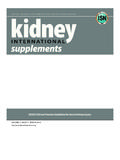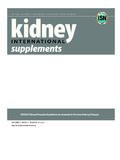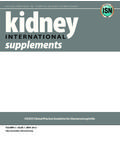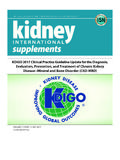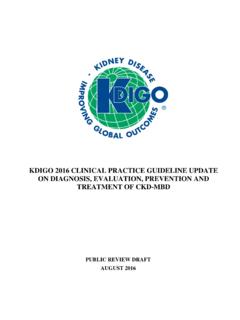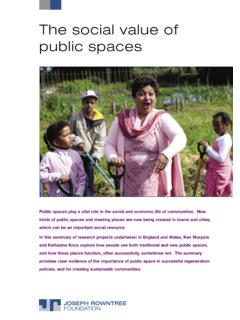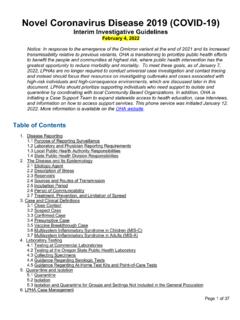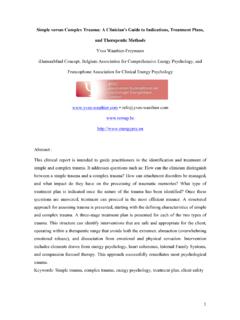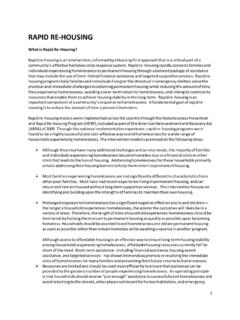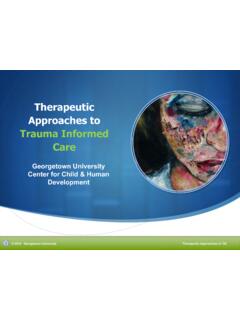Transcription of Position Paper Definition and Classification of Chronic Kidney …
1 Kidney International, Vol. 67 (2005), pp. 2089 2100 NEW INITIATIVED efinition and Classification of Chronic Kidney disease: Aposition statement from Kidney Disease: Improving GlobalOutcomes (KDIGO)ANDREWS. LEVEY,KAI-UWEECKARDT,YUSUKETSUKAMOTO,ADE ERALEVIN,JOSEFCORESH,JEROMEROSSERT,DICK DEZEEUW,THOMASH. HOSTETTER,NORBERTLAMEIRE,and GARABEDEKNOYANT ufts-New England Medical Center, Boston, Massachusetts; University Hospital Erlangen, Erlangen, Germany; Kasukabe ShuwaHospital, Saitama-ken, Japan; St. Pauls Hospital, Vancouver, British Columbia, Canada; John Hopkins Medical Institutions,Baltimore, Maryland; Hospital Tenon, Paris, France; University Hospital, Groningen, The Netherlands; National Institutes ofHealth, Bethesda, Maryland; Ghent University Hospital, Ghent, Belgium; and Baylor College of Medicine, Houston, TexasDefinition and Classification of Chronic Kidney disease: A po-sition statement from Kidney Disease: Improving Global Out-comes (KDIGO). Chronic Kidney disease (CKD) is a world-wide public health problem, with adverse outcomes of kidneyfailure, cardiovascular disease (CVD), and premature Definition and Classification of Kidney disease is nec-essary for international development and implementation ofclinical practice guidelines.
2 Kidney Disease: Improving GlobalOutcomes (KDIGO) conducted a survey and sponsored a con-troversies conference to (1)provide a clear understanding toboth the nephrology and nonnephrology communities of the ev-idence base for the Definition and Classification recommendedby Kidney Disease Quality Outcome Initiative (K/DOQI), (2)develop global consensus for the adoption of a simple defini-tion and Classification system, and (3)identify a collaborativeresearch agenda and plan that would improve the evidence baseand facilitate implementation of the Definition and classificationof Definition and Classification were accepted,with clarifications. CKD is defined as Kidney damage orglomerular filtration rate (GFR)<60 mL/ m2for3months or more, irrespective of cause. Kidney damage in manykidney diseases can be ascertained by the presence of albumin-uria, defined as albumin-to-creatinine ratio>30 mg/g in two ofthree spot urine specimens. GFR can be estimated from cali-brated serum creatinine and estimating equations, such as theModification of Diet in Renal Disease (MDRD) Study equa-tion or the Cockcroft-Gault formula.
3 Kidney disease severity isclassified into five stages according to the level of GFR. Kid-ney disease treatment by dialysis and transplantation should benoted. Simple, uniform classifications of CKD by cause and byrisks for Kidney disease progression and CVD should be : Chronic Kidney disease, glomerular filtration rate, protein-uria, albuminuria, for publication February 22, 2005 Accepted for publication February 28, 2005C 2005 by the International Society of NephrologyKidney failure is a worldwide public health problem,with increasing incidence and prevalence, high costs, andpoor outcomes [1]. There is even a substantially higherprevalence of the earlier stages of Chronic Kidney dis-ease (CKD), with adverse outcomes, including loss ofkidney function, cardiovascular disease (CVD), and pre-mature death. Strategies to improve outcomes will re-quire a global effort directed at the earlier stages of for a global initiative to address this prob-lem is simple and self-evident.
4 The epidemic of CKD isglobal. The adverse outcomes of CKD are universal, asare the underlying science and evidence-based strategiesfor prevention, detection, evaluation, and treatment. Al-though risk factors and resources for care vary locally, itis important to increase the efficiency of utilizing avail-able expertise and resources in improving the care andoutcomes of CKD , dissemination, and implementation ofclinical practice guidelines are means to improve out-comes of CKD. Rigorously developed evidence-basedclinical practice guidelines, when implemented, can re-duce variability of care, improve patient outcomes, andameliorate deficiencies in health care delivery [2 4]. Kid-ney Disease: Improving Global Outcomes (KDIGO) isarecently established and independently incorporatedorganization governed by an international board of di-rectors with the stated mission to improve the care andoutcomes of Kidney disease patients worldwide throughpromoting coordination, collaboration and integrationof initiatives to develop and implement clinical practiceguidelines [1].
5 One of the initiatives undertaken by KDIGO is a seriesof International Controversies Conferences that examinewhat is known, what can be done with what is known,and what needs to be known on selected issues that20892090 Levey et al: Chronic Kidney disease: Definition and classificationimpact on the care and outcomes of Kidney disease pa-tients worldwide. The first KDIGO International Contro-versies Conference on Definition and Classification ofChronic Kidney Disease in Adults was held in Amster-dam, The Netherlands, on November 16 and 17, 2004. Thetopics covered included the Definition and Classification ofCKD, estimation of glomerular filtration rate (GFR), andmeasurement of albuminuria and proteinuria. This arti-cle has been reviewed by the conference participants andreports the recommendations of the conference, whichhave been reviewed and adopted as a Position statementby the KDIGO Board of Kidney Foundation s Kidney DiseaseOutcomes Quality Initiative (K/DOQI) Clinical PracticeGuidelines on Chronic Kidney Disease: Evaluation, Clas-sification and Stratification of Risk published in 2002 pro-vided the first Definition of CKD independent of cause,and Classification of severity based on GFR level [5].
6 Theguidelines have been widely disseminated and generallyaccepted [6 13]. However, concerns have been expressedabout the Definition and Classification , methods to esti-mate GFR, and ascertainment of proteinuria [14 21].Thegoals for the KDIGO Controversies Conferencewere (1)toprovide a clear understanding to both thenephrology and nonnephrology communities of the evi-dence base for the K/DOQI Definition and classificationof severity of CKD; (2)todevelop global consensus forthe adoption of a simple Definition and Classification sys-tem for CKD, clarifications and modifications to currentguidelines to facilitate more widespread implementationof initiatives for patient care and physician and public ed-ucation worldwide; and (3)toidentify a collaborative re-search agenda and plan that would improve the evidencebase and facilitate the implementation of the definitionand Classification of CKDCONFERENCEKDIGO co-chairs (G. Eknoyan and N. Lameire) iden-tified Conference co-chairs (A.)
7 Levey and Eckardt)and worked together to develop the agenda and select in-dividuals with demonstrated expertise in CKD and inter-est in global issues regarding guideline was attended by 60 participants fromNorth and South America, Europe, Asia, Australia, andAfrica (Appendix 1). Plenary sessions and breakout ses-sions were designed to provide an overview of each ofthe three major topics, detailed discussions, and a sum-mary of clarifications and modifications of the K/DOQI guidelines, and suggestions for implementation, and rec-ommendations for research. Invitees were also encour-aged to submit abstracts of their work to complementthe discussion. The agenda and abstracts can be manuscript contains a brief sum-mary of the survey conducted prior to the meeting, aswell as the specific recommendations approved by theKDIGO Board of Directors at its meeting on December3and 4, 2004 in to the conference, a survey was developed anddisseminated to nephrologists worldwide to assess theiropinion of the K/DOQI Definition and Classification ofCKD.
8 The survey was designed to answer the followingquestions:What is the current practice for Definition of CKD, use ofaclassification system, estimation of GFR, and mea-surement of proteinuria?Is there agreement on the use of estimated GFR as a basisfor classifying CKD?What is the current knowledge on parameters requiredfor GFR estimates?Is there agreement on the use of spot urine samples formeasurement of proteinuria?What are potential barriers and concerns regarding im-plementation?Questions were drafted by conference planners, re-viewed and amended by KDIGO Board of Directors andother experts. A pilot version was tested, revised, andtranslated from English into French, German, Spanish,and Japanese. The final version of the survey contained25 questions and was distributed to approximately 10,000nephrologists via electronic mail. Mailing addresses werekindly provided by the International Society of Nephrol-ogy, European Renal Association-European Dialysis andTransplant Association, Spanish Society of Nephrology,Latin American Society of Nephrology, French Societyof Nephrology, and Japanese Society of , received from 1190 (12%) representingnephrologists in all continents (Table 1), were used toformulate the issues that the Controversies Conferencewould address.
9 The detailed results and analyses of theresponses received will be the subject of a separate and Classification of Kidney diseaseIn brief, respondents commented on the following withregard to Definition and Classification :K/DOQI system is frequently used already;Vast majority believe that it helps in identifying indi-viduals with CKD;Levey et al: Chronic Kidney disease: Definition and classification2091 Table responses by locationLocationNumberPercentNorth America25521 Central/South America837 United Kingdom343 Western Europe36531 Eastern Europe1079 Middle East625 Africa373 Asia/Japan14112 Asia/Other787 Australia/New Zealand232 Total1190100 About one third find it either not useful or would prefermodifications;Many requested inclusion of additional information, suchas cause of Kidney disease, and prognosis for kidneydisease progression or CVD; andSuggestions for revisions used inconsistent estimatesTheGFR estimates were evaluated as follows by therespondents:Many already were using equations to estimate GFR;Majority felt that GFR estimates should not be used alonefor the detection and follow-up of CKD;One third considered GFR estimation from equa-tions to be of less value than measured creatinineclearance;One fourth reported experience with the routine report-ing of GFR estimates whenever serum creatinine ismeasured, but almost one half envisaged problems withroutine reporting;Most believed that routine reporting of GFR estimateswould lead to more referrals;Many preferred the Cockcroft-Gault formula to theMDRD Study equation, although knowledge of thedeterminants and validity of either equation was sub-optimal.
10 AndThere was general uncertainty about the methods for cre-atinine assay used in local of albuminuria/proteinuriaIn terms of albuminuria/proteinuria, respondents re-sponded with the following concerns:Testing for albuminuria for the detection of CKD andassessment of risk for CVD is underutilized;More use assays for total protein rather than for albumin;Spot urine samples are less frequently used than timedurine collections; andOnly one third believe that spot urine samples maketimed collections THE ISSUESC onference attendees expressed widespread agree-ment about the following issues:(1) The burden of illness of CKD is high worldwide, butoutcomes and resources for care may vary acrosscountries. Irrespective of location, earlier identifica-tion should improve outcome. Strategies to improveidentification include increasing public awareness,professional education, changes in health care policy,changes in health care delivery systems, and basic,clinical and outcomes research related to CKD.
